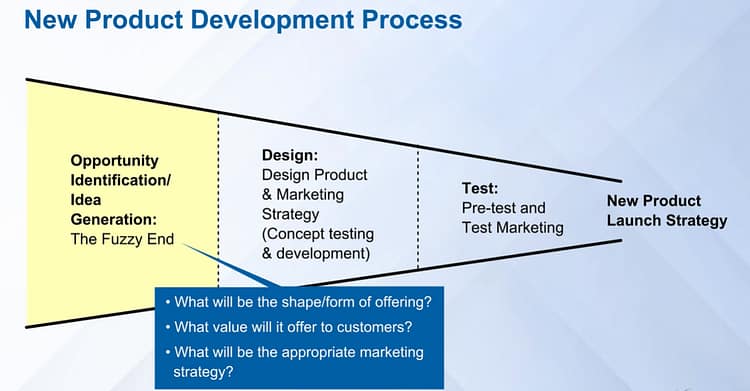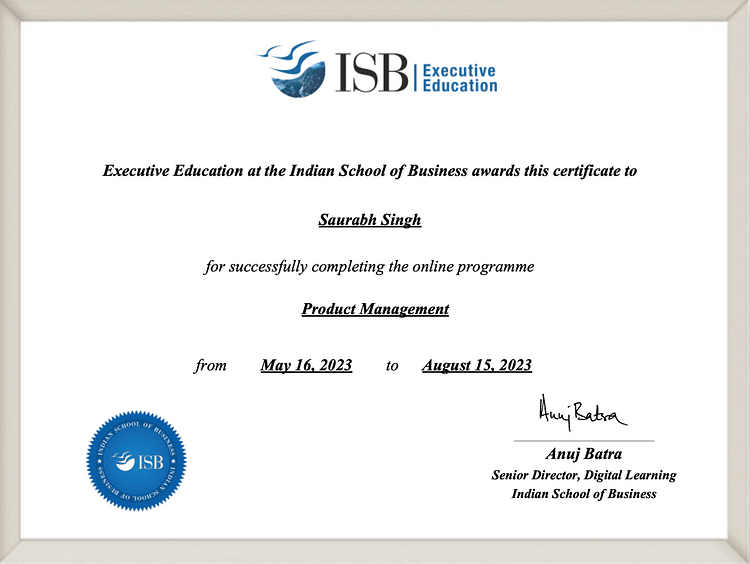In short…
- The role of design thinking in building an effective product portfolio.
- The importance of understanding customer needs in an efficient/effective product development process.
- How customer value dimensions positively influence the final product portfolio.
- Understand the role of marketing in the product development process, understand the concept of customer value, and the crucial role it plays in developing superior solutions.
- Create superior value for customers.
New Product Development Process
- Product development process: The 6 stages (with examples): https://asana.com/resources/product-development-process
- 7 Product development examples for UX: https://maze.co/collections/product-development/examples/

- Opportunity Identification and Idea Generation: Fuzzy Front end – we are not clear about how the product would look, value for customers, commercialization of the product, appropriate marketing strategy, etc – here we have endless opportunities and we use an elimination strategy to move to design
- Design: Design product and Marketing strategy (concept testing and development) – Marketing research for concept testing. Designing the value proposition of the product. The marketing research technique used is called Concept Testing
- Test: Pre-test and Test Marketing – Pretest marketing system (Assessor or Basis) is used to simulate the launch of the product. Test marking is the final test before the launch. It reduces the risk of failure before the launch
Markets are competitive, dynamic, and complex and there is no guarantee of success. The failure rate is 60-80% of new product launches. Using the NPD process is more likely to succeed.
Customer Needs and Behaviour
8 Examples of How Latent Needs Can Deliver Practical Innovation – https://blog.flexmr.net/latent-needs-deliver-practical-innovation
Layers of customers’ needs: The basic needs of the product should be important. Post that augmented needs of the consumers should be considered for creating additional features.
Milkshake for salespeople who want to buy the milkshake quickly, drive long for work

Types of needs:
Existing needs
Present in the minds of the customer
Can be expressed easily
A survey/interview can be used
e.g.: Condoms
Latent Needs
consumers do not realize it and cannot express if freely
Indirect techniques like observational methods, ethnographic research
High-risk, high rewards
e.g.: the iPhone launch met the latent needs
e.g.: Condoms with a thin membrane
Role of Marketing
- Understand consumer needs (existing/latent)
- Understand consumer problems
- Understand consumer behavior
- Segment consumers in groups so that consumers within a segment are similar in needs and different from other segments
- A targeting decision is taken for each segment. This leads to targeted customers.
- Segmentation, Targeting, Positioning
Elements of marketing mix: 4 Ps of marketing: Product, Price, Place, Promotion
- Create a value proposition using elements of the marketing mix
- Consumers perceive the proposed value to be superior
- Consumer experience matched the planned proposition
This is known as implementing the marketing strategy. 4Ps must be consistent to reach the same positioning goal.
Value for Customers
Consumer Values – https://strategyforexecs.com/customer-value/
The design stage of product development is aimed to offer a superior value solution to the customer
Consumers focus on the value of the product, not just the price
Value = (Perception of Benefit – Cost) over competition
Efforts must be made to make its value superior (loyalty programs, customer relationship programs) over the competitors
Customer Benefit Dimensions
- Economic: cost of the product
- Functional: features of the product
- Psychological: Intangible such as services, trust, brand, reputation, relationship
Value Curve
X-axis: Drivers of purchase (key attributes determining consumer choice) – cost of procurement, quality of product, availability, support from the company, disposal of the product
Y-axis: Suitable metric for each solution
Creating superior value for customers
- Reduce customer cost and effort
- Simplify the purchase process (Aldo shoe of my size was not available at the store. It was in the warehouse. But the cashier would not place the order till I have made the payment. In the end, I ended up buying shoes from a different store)
- Provide a convenient, pleasant, and entertaining experience
- Increase the cost of switching to a competitor
4 Ps of marketing for Zerodha
Let’s explore how Zerodha applies the 4 Ps:
- Product: Zerodha offers an online platform for individuals to trade in various financial instruments such as stocks, derivatives, mutual funds, and commodities. Their product is designed to provide a seamless and user-friendly experience, empowering customers to make informed investment decisions. Zerodha focuses on continuous innovation, introducing new features and tools to enhance the trading experience for its users.
- Price: Zerodha follows a unique pricing model in the brokerage industry known as “discount brokerage.” They offer low-cost trading services by charging a fixed and minimal brokerage fee per trade, regardless of the trade size. This pricing strategy has been instrumental in attracting a large customer base, particularly among cost-conscious traders and investors.
- Place: As an online brokerage, Zerodha operates primarily through its website and mobile application, making it accessible to users across India. They leverage technology to provide a robust and reliable trading platform, ensuring that customers can access their accounts and execute trades seamlessly from anywhere, anytime. Zerodha’s digital presence eliminates the need for physical branch offices, enabling them to reach a wider audience
- Promotion: Zerodha focuses on word-of-mouth marketing and has successfully built a strong brand reputation in the industry. They prioritize customer education and empowerment through various initiatives such as webinars, tutorials, and blogs. Zerodha’s educational content helps users understand the intricacies of investing and trading, fostering a sense of trust and loyalty among its customer base. Additionally, they leverage social media platforms and digital marketing to reach out to potential customers and promote their services effectively.
Note: These are notes from the ISB Executive Education – Product Management program for my personal consumption.
In case you are looking for a Product Management course, I would highly recommend joining this cohort-based course.
PS: You can connect with me for review or referral discount (link for referral discount)



